Complete Solutions to Only one option is correct for JEE Advanced of chapter CENTRE OF MASS, IMPULSE AND MOMENTUM of Class 11 book with complete answers and questions
| Class 11 | PHYSICS |
| Chapter | CENTRE OF MASS, IMPULSE AND MOMENTUM |
| DC PANDEY MASTER PROBLEM PACKAGE | Only one option is correct for JEE Advanced |
| Number Of Questions | 55 |
| Academic Year | 2023-24 |
As shown in the figure a body of mass m moving vertically with speed 3 m/s hits a smooth fixed inclined plane and rebounds with a velocity `v_(f)` in the horizontal direction . If angle of plane with horizontal is `30^(@)` , the velocity `v_(f)` will be

View SolutionA hemisphere of radius R and mass 4 m is free to slide with its base on a smooth horizontal table . A particle of mass m is placed on the top of the hemisphere . The angular velocity of the particle relative to centre of hemisphere at an angular displacement `theta` when velocity of hemisphere has become v is
View SolutionTwo blocks A and B of mass m and `2m` respectively are connected by a light spring of force constant k. They are placed on a smooth horizontal surface. Spring is stretched by a length x and then released. Find the relative velocity of the blocks when the spring comes to its natural length

View SolutionA ball of mass m approaches a heavy wall of mass M with speed 4 m/s along the normal to the wall. The speed of wall before collision is 1m/s towards the ball. The ball collides elastically with the wall. What can you say about the speed of the ball after collision? Will it be slightly less than or slightly higher than 6 m/s ?
View SolutionA tennis ball bounces down a flight of stairs, striking each step in turn and rebounding to half to height of the step. The coefficient of restitution is
View SolutionA gun fires a bullet. The barrel of the gun is inclined at an angle of `45^@` with horizontal. When the bullet leaves the barrel it will be travelling at an angle greater than `45^@` with the horizontal. Is this statement true or false?
View SolutionA small block of superdense material has a mass `(M)/(3)` , where M is the mass of earth . It is released from rest from a height h ( `lt lt ` radius of earth) from the surface of earth . The speed of the block at a height `(h)/(2)` is
View SolutionA block of mass `m` is pushed towards a movable wedge of mass `nm` and height `h`, with a velocity `u`. All surfaces are smooth. The minimum value of `u` for which the block will reach the top of the wedge is
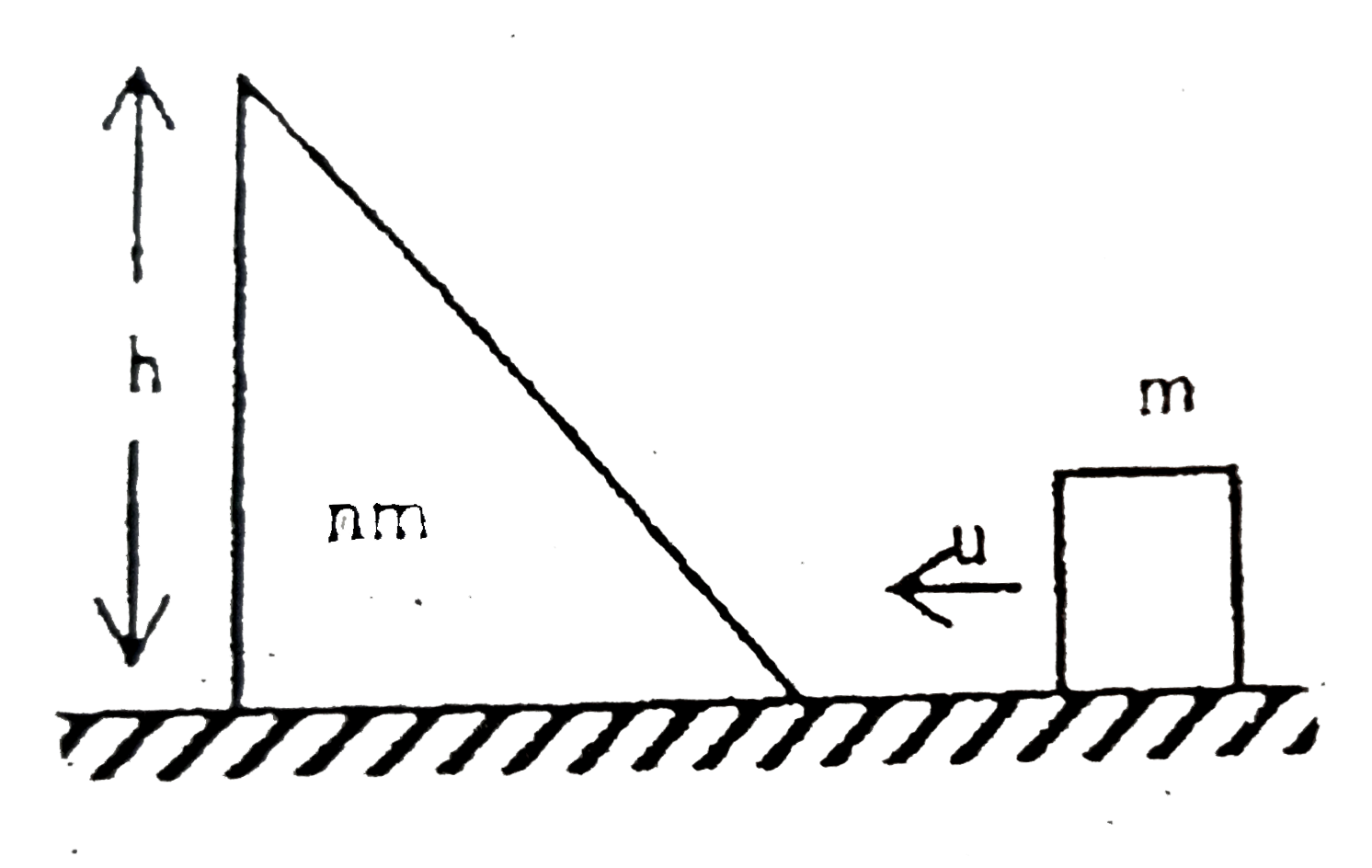
View SolutionA block of mass m slides down on inclined wedge of same mass m as shown in figure . Friction is absent everywhere . Acceleration of centre of mass of the block and wedge is

View SolutionA block A slides over an another block B which is placed over a smooth inclined plane as shown in figure . The coefficient of friction between the two blocks A and B is `mu` . Mass of block B is two times the mass of block A . The acceleration of the centre of mass of two blocks is
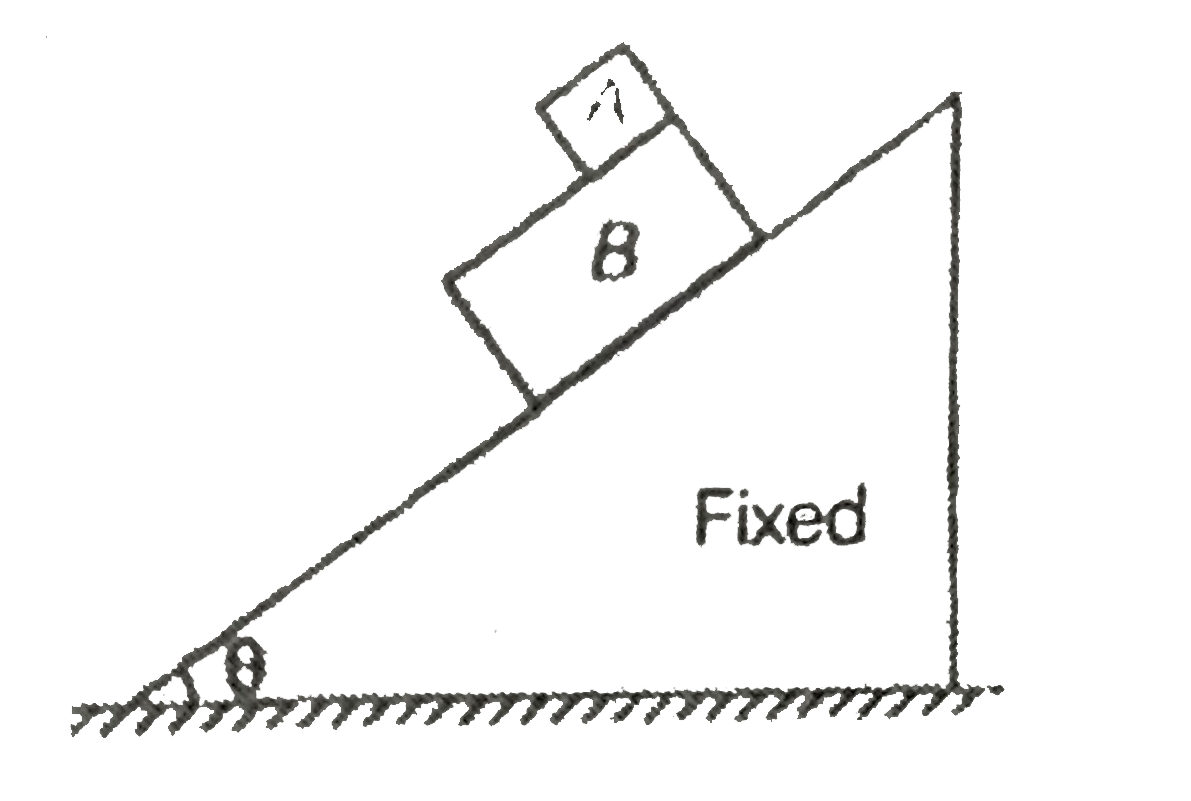
View SolutionThe momentum of a particle is `P = A + Bt^(2)` . Where , A and B are constant perpendicular vectors . The force acting on the particle when its acceleration is at `45^(@)` with its velocity is
View SolutionTwo blocks A and B of equal masses are attached to a string passing over a smooth pulley fixed to a wedge as shown in figure. Find the magnitude of acceleration of centre of mass of the two blocks when they are released from rest. Neglect friction.

View SolutionA rope thrown over a pulley has a ladder with a man of mass `m` on one of its ends and a counter balancing mass `M` on its other end. The man climbs with a velocity `v_r` relative to ladder. Ignoring the masses of the pulley and the rope as well as the friction on the pulley axis, the velocity of the centre of mass of this system is:
View SolutionTwo particles of equal mass have velocities `vec v_1 = 2 hat i= m//s^-1` and `vec v_2 = 2hat j m//s^-1`. First particle has an acceleration `vec a_1= (3 hat i+ 3 hat j) ms^-2` while the acceleration of the other particle is zero. The centre of mass of the two particles moves in a path of.
View SolutionA particle of mass `2m` is projected at an angle of `45^@` with horizontal with a velocity of `20sqrt2m//s`. After `1s` explosion takes place and the particle is broken into two equal pieces. As a result of explosion one part comes to rest. Find the maximum height attained by the other part. Take `g=10m//s^2`.
View SolutionA system of two blocks A and B and a wedge C are released from rest as shown in figure . Masses of the blocks and the wedge are m , 2m and 2m respectively . The displacement of wedge C when block B slides down the plane a distance 10 cm is ( neglect friction )
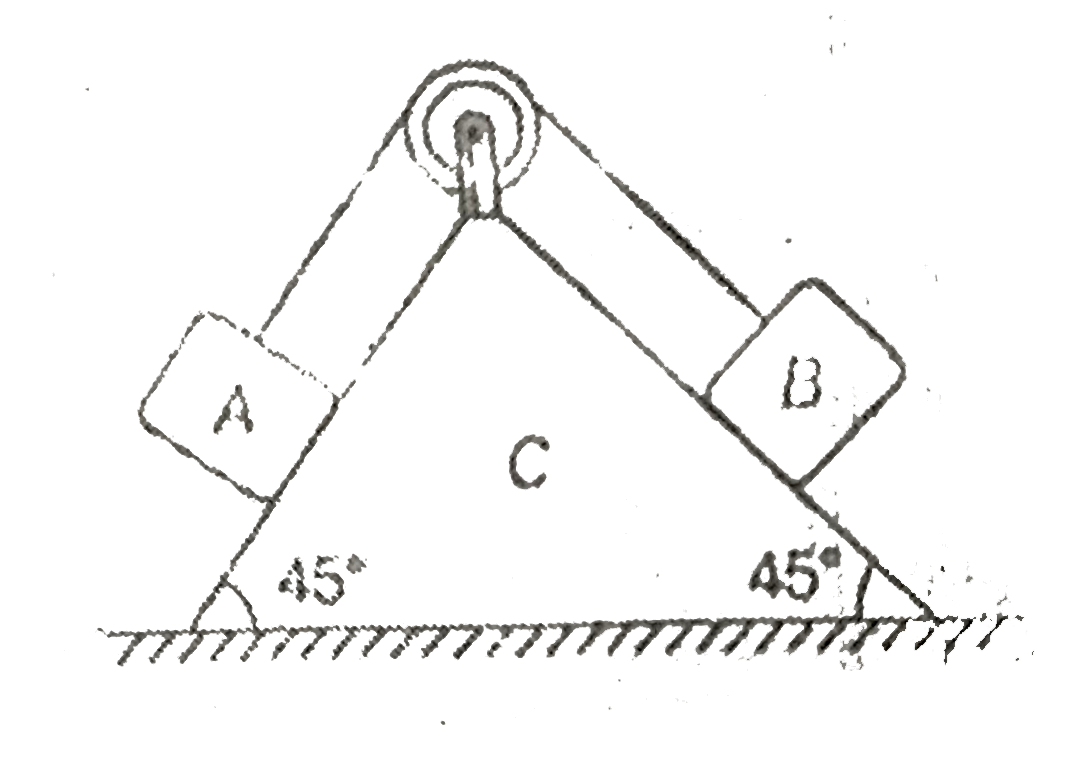
View SolutionA small sphere of radius R is held against the inner surface of larger sphere of radius `6R` (as shown in figure). The masses of large and small spheres are `4M` and M respectivley. This arrangement is placed on a horizontal table. There is no friction between any surfaces of contact. The small sphere is now released. Find the coordinates of the centre of the large spheres, when the smaller sphere reaches the other extreme position.

View SolutionA block of mass m slides over a smooth wedge of mass M which is placed over a rough horizontal surface . The centre of mass of the system will move towards left

Here `mu` = coefficient of friction between the wedge and the ground .
View SolutionTwo particles `A` and `B` of equal mass `m` are attached by a string of length `2l` and initially placed over a smooth horizontal table in the positoin shown in fig. particle `B` is projected across the table with speed `u` perpendicular to `AB` as shown in the figure. find the velocities of each particle after the string becomes taut and the magnitude of the impulse tension.

View SolutionA mass `m` rests on a horizontal table. It is attached to a light inextensible string which passes over a smooth pulley and carries a mass `m` at the other end. If the mass `m` is raised vertically through a distance `h` and is then dropped, what is the speed with which the mass `2m` begins to rise?

View SolutionTwo identical balls `A` and `B` are released from the position shown in Fig. They collide elastically with each other on the horizontal portion. The ratio of heights attained by `A` and `B` after collision is (neglect friction)

View SolutionA small block of mass M moves with velocity 5 m/s towards an another block of same mass M placed at a distance of 2 m on a rough horizontal surface . Coefficient of friction between the blocks and ground is `0.25` . Collision between the two blocks is elastic , the separation between the blocks , when both of them come to rest , is ( g = `10 m//s^(2)`)
View SolutionA gun fires a shell and recoils horizontally . If the shell travels along the barrel with speed v , the ratio of speed with which the gun recoils if (i) the barrel is horizontal (ii) inclined at an angle of `30^(@)` with horizontal is
View SolutionA body of mass `m_(0)` is placed on a smooth horizontal surface . The mass of the body is decreasing exponentially with disintegration constant , `lambda` . Assuming that the mass is ejected backwards with a relative velocity u . If initially the body was at rest , the speed of body at time t is
View SolutionA ballon has 2 g of air . A small hole is pierced into it . The air comes out with relative velocity 4 m/s . If the balloon shrinks completely in `2.5` s , the average force acting on the balloon is
View SolutionIn a one-dimensional collision between two identical particles. A and B, B is stationary and A has momentum `p` before impact. During impact, B gives an impulse J to A. Find the coefficient of restitution between A and B?
View SolutionA ball A is falling vertically downwards with velocity `v_(1)` . It strikes elastically with a wedge moving horizontally with velocity `v_(2)` as shown in figure . What must be the ratio `(v_(1))/(v_(2))` , so that the ball bounces back in vertically upward direction relative to the wedge
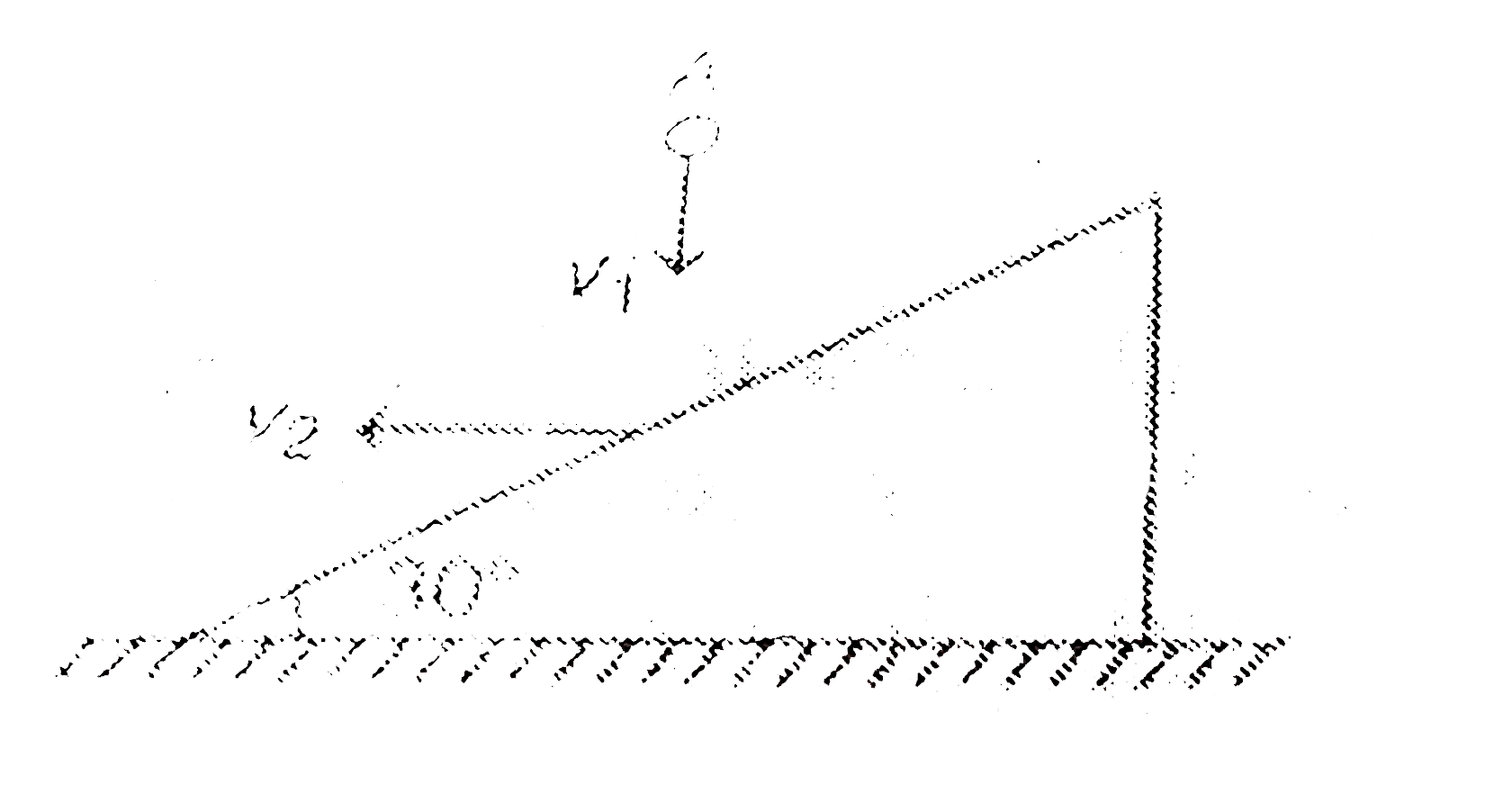
View SolutionA ball is projected from the point O with velocity 20 `m//s` at an angle of `60^(@)` with horizontal as shown in figure. At highest point of its trajectory it strikes a smooth plane of inclination `30^(@)` at point A. The collision is perfectly inelastic. The maximum height from the ground attained by the ball is `(g=10 m//s^(2))`

View SolutionA bullet of mass 'm' moving with velocity 'u' passes through a wooden block of mass `M = nm` as shown in figure. The block is resting on a smooth horizontal floor. After passing through the block, velocity relative to the block is
 .
.
View SolutionA ball of mass `m` collides with the ground at an angle. With the vertical. If the collision lasts for time `t`, the average force exerted by the ground on the ball is : (e = coefficient of restitution between the ball and the ground)
 .
.
View SolutionA small ball falling vertically downward with constant velocity 2`m//s` strikes elastically an inclined plane moving with velocity 2`m//s` as shown in figure. The velocity of rebound of the ball with respect ground is

View SolutionTwo blocks of mass m and 2m are kept on a smooth horizontal surface. Theya are connected by an ideal spring of force constant k. Initially the spring is unstretched. A constant force is applied to the heavier block in the direction shown in figure. Suppose at time t displacement of smaller block is `x_(1)` then displacement of the heavier block at this moment would be

View SolutionBlocks A and B shown in the figure are having equal masses m. The system is released from rest with the spring unstretched. The string between A and ground is cut, when there is maximum extension in the spring. The acceleration of centre of mass of the two blocks at this instant is

View SolutionBoth the blocks as shown in figure are given together a horizontal velocity towards right. The acceleration of the centre of mass of the system of block is `(m_(A) = 2m_(B) = 2kg)`.

View SolutionA particle of mass 3m is projected from the ground at some angle with horizontal. Its horizontal range is R. At the highest point of its path it breaks into two pieces of masses m and 2m respectively. The smallar mass comes to rest. The larger mass finally falls at a distance x from the point of projection where x is equal to
View SolutionA girl throws a ball with an initial velocity v at an angle `45^@`. The ball strikes a smooth vertical wall at a horizontal distance d from the girl and after rebound returns to her hands. What is the coefficient of restitution between wall and ball ? `(v^2 gt dg)`
View SolutionA ball collides at `B` with velocity `10m//s` at `30^(@)` with vertical. There is a flag at `A` and a will at `C`. Collision of ball with groundis perfectly inelastic `(e=0)` and that with wall is elastic `(e=1)`. Given `AB = BC=10 m`. Find the time after which ball will collide with the flag.

View SolutionThe lower end of a 4 m long uniform rod AB is pulled with constant speed v=4 `m//s`. The speed of centre of mass of the rod at `theta=60^(@)` will be
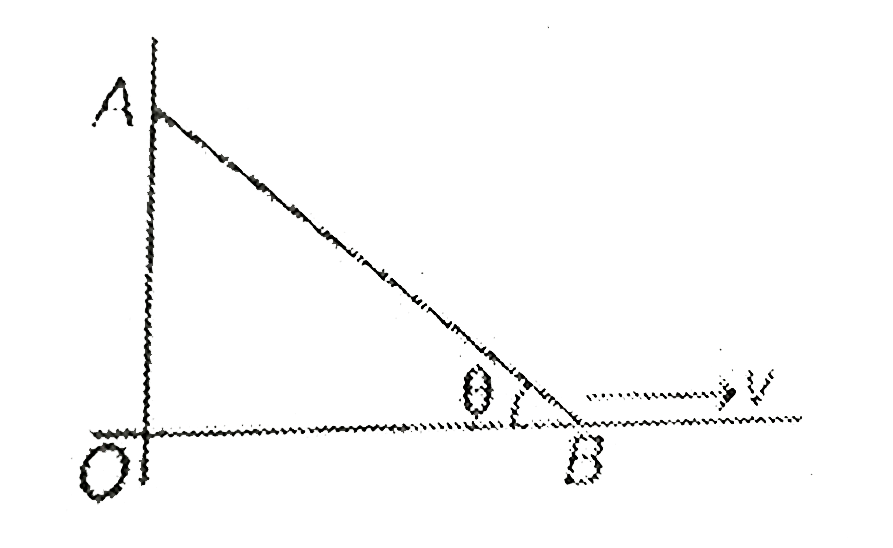
View SolutionA rigid rod leans against a vertical wall (y-axis) as shwon in figure. The other end of the rod is ion the horizontal floor. Point A is pushed downwards with constant velocity. Path of the centre of the rod is

View SolutionA bullet of mass m moving vertically upwards instantaneously with a velocity 'u' hits the hanging block of mass 'm' and gets embedded in it, as shown in the figure. The height through which the block rises after the collision. (assume sufficient space above block) is:

View SolutionA super-ball of mass m is to bounce elastically back and forth between two rigid walls at a distance d from each other. Neglecting gravity and assuming the velocity of super-ball to be `v_(0)` horizontally, the average force being exerted by the super-ball on each wall is
View SolutionA block of mass M with a semicircualr of radius R, rests on a horizontal frictionless surface. A uniform cylinder of radius r and mass m is released from rest the top point A The cylinder slips on the semicircular frictionless track. How far has the block moved when the cylinder reaches the bottom (point B) of the track ? How fast is the block moving when the cylinder reaches the bottom of the track?

View SolutionA block of mass M with a semicircualr of radius R, rests on a horizontal frictionless surface. A uniform cylinder of radius r and mass m is released from rest the top point A The cylinder slips on the semicircular frictionless track. How far has the block moved when the cylinder reaches the bottom (point B) of the track ? How fast is the block moving when the cylinder reaches the bottom of the track?

View SolutionA skater of mass m standing on ice throws a stone of mass M with a velocity of v in a horizontal direction. The distance over which the skater will move back (the coefficient of friction between the skater and the ice is `mu`)
View SolutionA small ball on a frictionless horizontal surface moves towards right with velocity v. It collides with the wall and returns back and continues to and fro motion. If the average speed for first to and fro motion of the ball is `((2)/(3))`v, then the coefficient of restitution of impact is

View SolutionA body of mass `m` is dropped from a height of `h`. Simultaneously another body of mass `2m` is thrown up vertically with such a velocity `v` that they collide at height `h/2`. If the collision is perfectly inelastic, the velocity of combined mass at the time of collision with the ground will be
View SolutionTwo bars of masses `m_1` and `m_2` connected by a weightless spring of stiffness `k`, rest on a smooth horizontal plane. Bar `2` is shifted by a small distance `x_0` to the left and released. The veloicyt of the centre of mass of the system when bar 1 breaks off the wall is

View SolutionA rocket is projected vertically upwords. It explodes at the/ topmost point of its trajectory into three identical fragments . One of the fragments comes straight down in time t 1 while the1 other two land at a time `t_(2)` after explosion. Find the height at which the explosion ocurred in terms of `t_(1) and t_(2)` ?

View SolutionA raindrop as it falls through for or mist collects mass at a uniform rate. The drop starts from rest with zero radius and remains spherical at all times. The acceleration with which it falls
View SolutionA small block of mass 'm' is placed on bigger block of mass `M_(1)` which is placed on a fractionless horizontal surface. The two blocks are given equal speed `u_(1)` but opposite directions, as shown in the figure. After sometime, it is observed that both blocks are moving in the direction of motion of the lower block, with a speed greater than `(u)/(2)`. It can be concluded that -

View SolutionA trolley is moving horizontally with a constant velocty of `v m//s` w.e.t. earth. A man starts running from one end of the trolley with velocity `1.5v m//s` w.r.t. to trolley. After reaching the opposite end, the man return back and continues running with a velocity of `1.5 v m//s` w.r.t. the trolley in the baclward direction. If the length of the trolley is L then the displacement of the man with respect to earth during the process will be :-

View SolutionA bullet of mass `m` penetrates a thickness `h` of a fixed plate of mass `M`. If the plate was free to move, then the thickness penetrated will be
View SolutionA small particle is placed at the top point A of a fixed smooth hemisphere of radius R. Particle is given small displacement towards right and it starts slipping. Calculate velocity of the particle after hitting horizontal perfectly inelastic surface.

View SolutionThree masses A, B and C are kept on a smooth horizontal surface as shown in the fiugre. A sharp impulse is given to the mass A, so that it starts moving towards B with speed `v_(0)`. What is the minimum value of m so that there is only one collision between masses A and B (all collisions are elastic)

View SolutionA block of mass m is attached with a spring of force constant k. The block is kept on a frictionless plank. Mass of the plank is M and it is also kept on a horozontal frictionless surface. Initially the sysetm is stationaryl. An impulse p is applied on the block as shown. The maximum copression in the spring will be

View Solution
Only one option is correct for JEE Advanced questions and complete solutions for chapter CENTRE OF MASS, IMPULSE AND MOMENTUM of DC PANDEY PHYSICS (HINGLISH) of Class 11